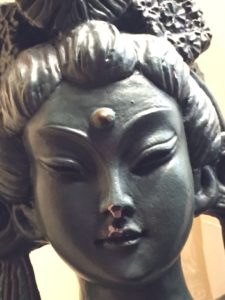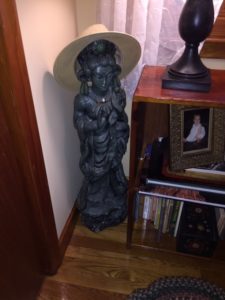 The Kuan Yin
The Kuan Yin
She keeps watch in the warm corner of my bedroom, her bearing almost more regal for the rivers of cracks and generous chips that mark her faded turquoise. Her right hand, the deliverer of action, folds into Gyan Mudra, the gesture of consciousness. Preparing to take her picture, I haul myself into the present moment as an honoring of what she is and what she represents.
This statue doesn’t move. Her eyes don’t shift to follow my movements. She is alive nonetheless, imbued with a love deep and rare, a love that springs from her most famed attribute, compassion.
My father gave this Goddess to my mother sometime in the mid seventies. I imagine he was making an effort to support her blooming love of Yoga and meditation. The statue moved out when my mother and I did, after the divorce, and took up residence in the corner of the small apartment. When my mum moved to a different building, Kuan Yin settled into another corner without complaint. This is where my daughter, Bink, first met her.
Bink, my mother’s first granddaughter, was delayed in nearly every aspect of development. She never crawled, and didn’t manage to pull herself up to standing until she was over two years old. During each visit to Grandma’s place, the turquoise Goddess of Compassion was witness to Bink’s ongoing challenges and triumphs. At three feet high and graced with numerous curves that made excellent grab bars, Kuan was a natural assistant during the pull-up -to-stand phase. As the relationship between my mother and my daughter deepened, so did the one between child and Goddess.
Part of the way autism presents in my daughter is her unrelenting adherence to self-made rules and rituals. Each time Bink visited Grandma’s place, she lurched or toddled or otherwise found her way to Kuan Yin in the corner. Bink developed a real attachment to Kuan Yin. She loved to touch the smooth blue-green skin and garments. Perhaps the coolness felt good to her frazzled nervous system. My mum photographed these encounters several times, inadvertently documenting Bink’s physical growth. Though I can’t find any of those old photos now, the memory of them is clear in my mind.
I loved it when my daughter spent time with her grandmother. It gave me a much needed break from a child who didn’t sleep through the night and often wore me out with her intense and unusual needs for…well, almost everything, except perhaps socialization. My mum grew to understand Bink in a way that few others did. She understood the bizarre food preferences, the need for space and the simultaneous obsessive-compulsive need to touch people’s noses. She celebrated my daughter’s triumphs and her quirks almost as much as I did ( and do). Kuan Yin was there to witness much of this.
During one of Bink’s Grandma visits, She grabbed Kuan Yin overzealously and the turquoise wonder toppled to the floor and broke into a multitude of pieces. The statuesque Goddess had the grace to land in a way that caused no injury to my daughter, but there was some devastation nonetheless. What would visits to Grandma be like without the reassuring presence of the dear clay lady in the corner? Luckily, we didn’t have to suffer long enough to find out!
Enter my brother S. He loved model cars and planes when he was a kid, and he still excelled in his ability to visualize solutions to problems and then manifest them. S glued back every little piece of Kuan Yin, and though she bears scars that tell this tale, she stood once again tall and strong in Grandma’s corner.
When my mum had to vacate her apartment to live in an assisted living facility, Kuan Yin came home with me. At twenty five years old, Bink no longer shows an attachment to her. That doesn’t diminish her power one bit in my eyes. The one who symbolizes my favorite attribute will always have a place in my corner, wherever that may be. She is a testament to a deep love that springs from a compassionate heart, the bond between my mother and my daughter.
–Melinda Coppola
On Turkeys and Traffic and TIme